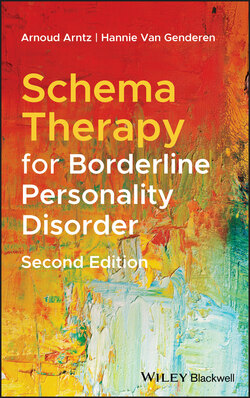Читать книгу Schema Therapy for Borderline Personality Disorder - Hannie van Genderen - Страница 51
Structure of sessions during active treatment
ОглавлениеWhen the phase of case conceptualization is rounded off, the therapist starts with working with the modes. In order to discover which mode is most active at the beginning of a session he starts with a general question like “how was your week?”, “how have you been doing since we last met?” or “what do you want to discuss with me today?”. Don't talk too long about what happened (roughly 5 min) and try to find out which mode is active. The therapist can form an idea of the mode that is “talking” from the tone of voice of the patient in combination with the content of the story (Table 3.2) (see ST step by step 2.17 and 5. Examples of modes).
When the therapist is pretty sure which mode is talking, he states which mode he thinks is active. So, don't ask the patient to tell which mode is active, because in the first phase of treatment the patient is usually not able to tell you which mode, she is in. She is convinced that there is no mode and she answers “I am telling this.”
The following step is that the therapist uses a technique appropriate for that mode. This can be all kind of techniques (see Chapter 9). Be aware that there can be a lot of mode flipping during the session, so you have to adapt your strategy a few times. The ultimate goal of each session is to reach the vulnerable child. As soon as the vulnerable child appears the therapist does everything to support and comfort the vulnerable child and provides psychoeducation about needs. Try to help the vulnerable child to grow emotionally by fulfilling unmet needs in such a way that this matches with the phase of growth the patient is in. The therapist must be aware of the fact that practical solutions mostly are not the best way to support the vulnerable child in the beginning of therapy, because the patient is not able to perform the suggested actions. Only when the vulnerable child feels comforted enough for the moment the therapist can give some psychoeducation about possibilities to solve the problem or accepting that things cannot be changed immediately. In a later phase of therapy, he can stimulate the patient to find her own solutions by learning her problem solving. Working with the mode(s) takes between 15 and 30 min.
Table 3.2 Different reactions possible in the first moments of the session. Question: “How was your week?”
| Tone of voice | Content | Mode |
|---|---|---|
| Flat without emotion | I am okay. No nothing special happened. I think we can have a short session today. | Detached protector |
| Harsh, negative | I had a bloody awful week, everything went wrong. I am such a fool. | Punitive parent |
| Sad, anxious, panicky with a childlike tone | I had a terrible week. I felt sad and lonely. I am afraid that my friend is going to leave me. | Abandoned/abused child |
| Angry, loud, incoherent | Everything goes wrong. Everybody is against me. Starts mentioning a lot of examples of negative experiences in which he/she was treated unfair. | Angry child |
| Calm, shows emotions in an appropriate way | Some things went well and some things went wrong. I would like to talk about the situation that made me sad. I want to find out why this happened. | Healthy adult |
It is strongly recommended to not postpone experiential techniques to later phases of therapy. The idea that it is contraindicated to use for instance empty chair techniques or imagery rescripting of aversive childhood memories early in treatment has been proven wrong. By using such techniques, the detached protector mode is bypassed, the abandoned/abused child mode is supported and healed, and the punitive parent mode weakened. Thus, the current treatment model states that almost every session of this central phase should contain experiential work, and that one should start within a few minutes with this, to prevent that one avoids emotional work and runs out of time. Talking and understanding can be done at the end of the session.
Be sure to reserve around 5–10 min at the end of each session to draw conclusions on schema and mode change and to strengthen the healthy adult.
